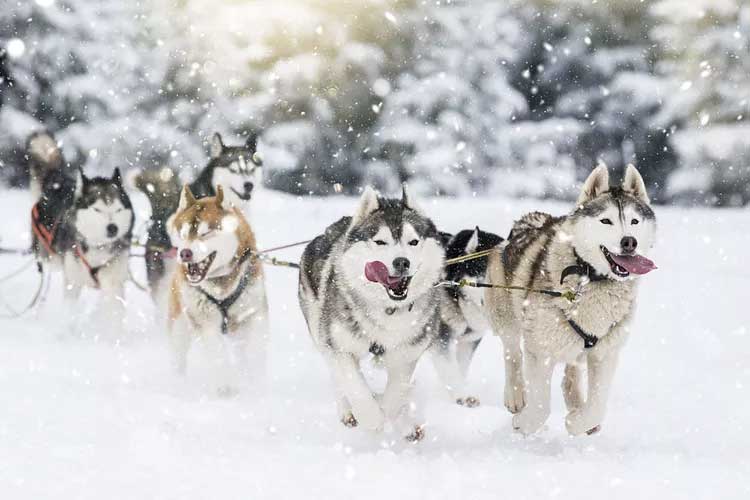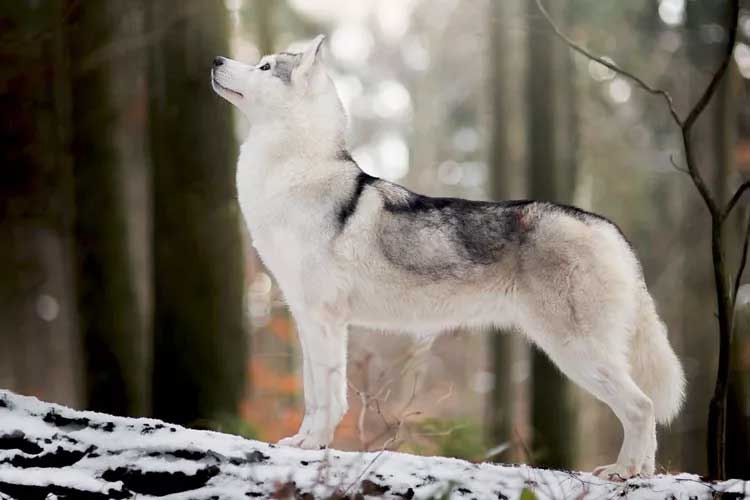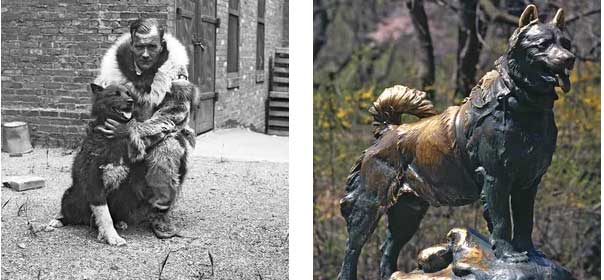
Siberian Husky Overview
| OFFICIAL NAME | Siberian Husky |
| COMMON NAME | Siberian Husky |
| PET HEIGHT | 20 to 23 inches |
| PET WEIGHT | 35 to 60 pounds |
| LIFESPAN | 12 to 15 years |
| GOOD WITH | children, dogs, families |
| TEMPERAMENT | friendly, outgoing, playful, willful |
| INTELLIGENCE | high |
| SHEDDING AMOUNT | normal |
| EXERCISE NEEDS | high |
| ENERGY LEVEL | active |
| VOCAL LEVEL | howler |
| DROOL AMOUNT | low |
| BREED GROUP | working |
| BREED SIZE | medium (26-60 lbs.) |
| COAT LENGTH | medium |
| COLORS | black, gray, red, white |
| PATTERNS | bicolor, sable |
| OTHER TRAITS | apartment-friendly, cold weather tolerant, easy to groom, good hiking companion, high prey drive, strong loyalty tendencies |
A Siberian husky is born to run—with or without you! "They're mischievous, fun dogs who need an active owner who can keep them well-exercised," says Brita Kiffney, DVM, DABVP, of Northshore Veterinary Hospital in Bellingham, Wash., and outreach chair of the American Board of Veterinary Practitioners. "A secured yard is key to prevent any accidents."
You don't need to sled over the tundra to enjoy a Siberian's company, but they do love the cold and snow. Built to move and protected by a thick double coat, they'll romp and chase all day in the winter's chill if you let them. Huskies are independent, smart, and welcoming to anyone who comes to visit. As natural pack animals, they need to interact with both their human companions and medium- to large-size dogs like them, so expect to line up many dog park playdates.
Appearance
Striking" is the best word to describe a Siberian husky's beauty. He holds your gaze with bright, piercing, almond-shaped eyes in colors such as amber, blue, and brown. Some Siberians have bi-eyes, which means one brown eye and one blue; or they're parti-eyed, defined as half-brown and half-blue eyes.Faces—also called "masks"—are white, and distinguished by an elongated snout (which helps warm air in cold climates) and an alert, focused expression. At first, a Siberian looks almost too striking to approach until his jaw drops and out rolls his tongue and a natural smile.
The Siberian husky's two-layered insulated coat provides great cold protection—straight and thick on the outside, short and downy soft underneath. Coats feature various tones of red, gray, black, as well as snow white, patterned in variations of red-and-white, black-and-white, and gray-and-white. Vibrant hues encircle their muscular shoulders and rise to the tips of high triangular ears. Color then forms a forehead cap to create an illusion of raised eyebrows, especially when they look askew at you to determine if it's time to go for a run.
Built for speed and endurance, a Siberian husky dog is compact, standing about 23 inches high at the withers and weighing between 35–60 pounds. He's sleek and evenly proportioned from his nose tip to the end of his long, bushy tail, with hindquarters slightly angled to help propel him forward.
Temperament
Your Siberian husky will tempt you with his playful demeanor and eager attitude. He's ready to try anything that involves movement and satisfies his curious mind. Pull a wagon full of kids? Sure! Go for a jog? Absolutely! Snowshoe all Saturday morning? Lead the way!Outgoing and friendly, a Siberian greets anyone who comes to the door with a sniff and maybe a head bump, sweeping the floor with his wagging tail. He's a wonderful host—which means he's not remotely interested in keeping anyone away, so scratch "guard dog" off your list.

Siberian husky dogs don't bark much, but they are talkative. They might moan and whine to get your attention, especially if they think they deserve glowing praise for not dashing out an open door. They also express themselves through a long, melodic howl in response to sirens, other Siberians, or just to say good morning. It's a beautiful song! While you don't want to suppress this natural call of the wild, you might need to condition your Siberian to quiet it at your command, reinforced by a treat and a loving pat.
A Siberian won't live to please you, but he adores being with you and the family. Pack mentality lies deep within his DNA, so he's happiest when socializing and doing tasks. Leaving this working dog alone for long stretches of time makes him anxious and determined to break free from his crate, leash, fence, or whatever else is holding him back.
Delaware Valley Siberian Husky Rescue (DVSHR) states that training consistency and rewarding good behavior are two essential actions that make life with your Siberian the best it can be for both of you. Find a skilled trainer to help with no-no behaviors such as stress chewing, mouthing—which is when a dog takes part of you between his teeth but doesn't engage his jaw to bite—jumping on people, and door bolting.
Living Needs
As long as you keep a Siberian active and busy, he'll thrive in just about any environment.His natural tendency is to travel hundreds of miles exploring, so keep this in mind as you set up his home. A large yard with a tall fence—at least 5 feet high—is ideal, but also bury the bottom of it 1 foot deep and reinforce it with mesh or chicken wire. He'll easily shimmy under any gap in the fence line and zip off in search of new horizons.
The Siberian husky can be characterized as a "Houdini hound"—a talented escape artist with a knack for finding the weak point of any form of containment and busting out. In his own mischievous way, he considers it a challenge to succeed, and his persistence requires your diligence. Lillian Su, BS, DVM, MVSc, of Sunstone Veterinary Specialists provides some additional tips for managing this behavior. It's also vital to microchip your husky, just in case he pulls off an escape.
However, there's an inherent trait of a Siberian that you can only accommodate, never stop completely: digging. He'll excavate a lot because his Arctic ancestors dug in the snow to form protective dens and hide food. The folks at DVSHR suggest building a sandpit in the corner of your yard to use as a training tool to channel this instinctive energy. You can hide toys there and reward him for finding them, reinforcing behavior to this particular spot. Also combine long walks with chances to dig in a forest, on a sandy shore, or another safe public space where it's allowed.

If you like to roam, a Siberian is your best loyal pal. You might notice that while on leash or in a harness, he'll lead (he is a sled dog, after all!) so take advantage of this in a controlled way. Plot trail runs, carve out new woodland paths, and—by all means—frolic in the snow whenever possible. A behavioral trainer can devise a strategy for working with you, him, and even other animals.
Siberians love their packs, but not all its members. Kiffney says they have a high prey drive, and may not be good with small dogs or family cats. Keep your friendly pup engaged at dog parks that cater to larger dogs.
Care
A standard feature of the Siberian husky is his "self-cleaning" function. He's not smelly, and you'll only have to bathe him a few times a year."He won't need to be brushed regularly, but sheds quite a bit throughout the year, and then an extra amount twice annually," Kiffney says. Siberians who live in warmer climates tend to shed more. Occasional brushing should do the trick during low shedding season, but be sure to brush daily when the fur is really flying—a process known as "blowing coat." A metal comb and pin brush help remove the old undercoat.
For healthy teeth and fresh breath, use a toothbrush and toothpaste designed for dogs to give your Siberian a regular dental polish. His nails might need a trim every couple of weeks or so.
Health
Compared to some other breeds, a Siberian husky's lifespan is long: Usually 12–15 years. During this time, he stays fairly healthy. Combined with a nutritious diet, his metabolism and exercise levels keep him lean, and he doesn't suffer from a lot of ailments. However, two particular conditions you should know about before adding a Siberian to the family are hip dysplasia and eye problems.Hip dysplasia can be a genetic condition or it can develop over time. Either the thigh bone doesn't fit securely in the hip socket, or cartilage wears away between the bones, creating painful arthritis. Your veterinarian may recommend medication to ease mild cases of hip dysplasia and more severe instances frequently require surgery.

Three eye problems may cause blindness: Corneal dystrophy, juvenile cataracts, and progressive retinal atrophy. A Siberian can still live a rich, full life even without sight, but it's important to choose your new companion from a breeder who follows guidelines established by the Canine Health Information Center. For adult dogs, consult with your vet about testing recommendations.
History
If you ever need to provide some canine trivia, here's an interesting point: Siberian huskies can be traced back to a wolf ancestor that's more than 35,000 years old.Researchers believe that Siberian Taimyr wolves provided some of the bloodline used by the Chukchi—indigenous people of Russia who inhabit far northeastern Siberia—when they developed a cold-resistant canine. The Chukchi wanted working dogs that could not only be good family companions, but also haul sleds and light loads as these semi-nomadic tribes traversed frozen terrain. Those dogs are the ancestors of Siberian huskies. Nordic dogs like Siberians are considered part of the spitz group that originated in North America, Russia, and Scandinavia.

In 1925, Siberian huskies became more famous when mushers led relay teams of these sled dogs over 650 miles in less than six days to deliver recovery serum to Nome, Alaska, where a diphtheria epidemic was raging. Known as "The Great Race of Mercy," the feat was so remarkable for that time that the lead dog of one team, Balto, is memorialized with a statue in New York City's Central Park.
Some huskies occasionally hit the racing circuit—in fact, the breed's cute face is on the logo for the iconic Iditarod Trail Sled Dog Race. But it's more common now for mushers to use Alaskan huskies, a mix of Canadian Inuit (Eskimo) dogs, German shorthaired pointers, and purebred Siberians.
Fun Facts
Siberian huskies are movie stars! There are three different animated films about Balto, the famous Siberian who led the final leg of the "serum run" to Nome, Alaska, in 1925. Musher and breeder Leonhard Seppala had another lead Siberian, Togo, who actually traveled more than 250 miles of that trip and was eventually immortalized in the 2019 live-action feature Togo, featuring one of his descendants, Diesel, in the starring role.Disney has released multiple husky-based movies as well: The 1994 biopic Iron Will, in which a young boy and his Siberian race to save the family farm. The slapstick comedy Snow Dogs in 2002. And the 2006 survival film Eight Below, based on the true story of Siberian huskies left behind in Antarctica after their expedition abruptly ended.
Movie stars also love Siberian huskies. Some famous past and present Siberian owners include Jared Leto, Ben Stiller, and Leonardo DiCaprio.